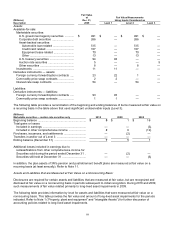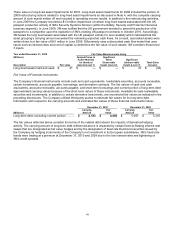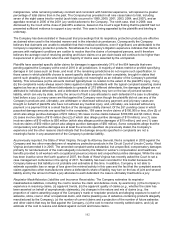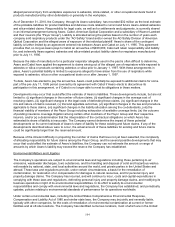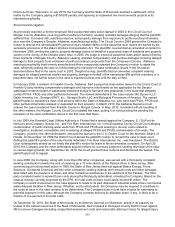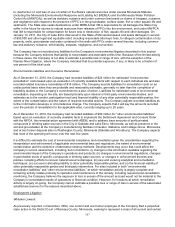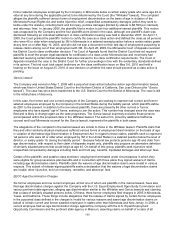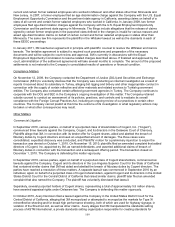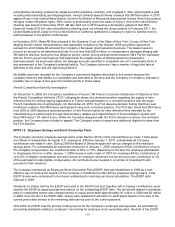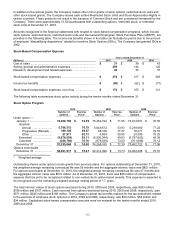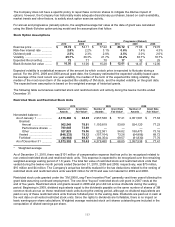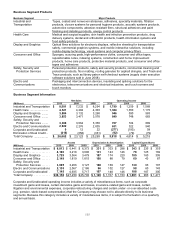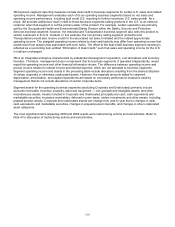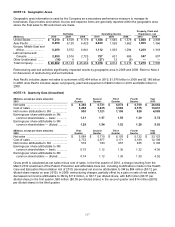3M 2010 Annual Report Download - page 113
Download and view the complete annual report
Please find page 113 of the 2010 3M annual report below. You can navigate through the pages in the report by either clicking on the pages listed below, or by using the keyword search tool below to find specific information within the annual report.
107
to, destruction of, and loss of use of certain of the State’s natural resources under several Minnesota Statutes
(including the Minnesota Environmental Response and Liability Act (MERLA) and the Minnesota Water Pollution
Control Act (MWPCA)), as well as statutory nuisance and under common law based on claims of trespass, nuisance,
and negligence with respect to the presence of PFC’s in the groundwater, surface water, fish or other aquatic life and
sediments. The State also seeks declarations under MERLA that 3M is responsible for all damages the State may
suffer in the future for injuries to natural resources from releases of PFCs into the environment, and under MWPCA
that 3M is responsible for compensation for future loss or destruction of fish, aquatic life and other damages. On
January 14, 2011, the City of Lake Elmo intervened in the State of Minnesota lawsuit and seeks damages in excess
of $50,000 and other legal and equitable relief, including reasonable attorneys’ fees, for alleged contamination of city
property, wells, groundwater and water contained in the wells with PFCs under several theories, including common
law and statutory nuisance, strict liability, trespass, negligence, and conversion.
The Company has not recorded any liabilities for the Company’s environmental litigation described in this section
because the Company believes that liability is not probable and estimable at this time. Because of the limited activity
in these cases, the Company is not able to estimate a possible loss or range of loss, with the exception of the
Passaic River litigation, where the Company indicated that its potential exposure, if any, is likely to be a fraction of
one percent of the total costs.
Environmental Liabilities and Insurance Receivables
As of December 31, 2010, the Company had recorded liabilities of $24 million for estimated “environmental
remediation” costs based upon an evaluation of currently available facts with respect to each individual site and also
recorded related insurance receivables of $15 million. The Company records liabilities for remediation costs on an
undiscounted basis when they are probable and reasonably estimable, generally no later than the completion of
feasibility studies or the Company’s commitment to a plan of action. Liabilities for estimated costs of environmental
remediation, depending on the site, are based primarily upon internal or third-party environmental studies, and
estimates as to the number, participation level and financial viability of any other potentially responsible parties, the
extent of the contamination and the nature of required remedial actions. The Company adjusts recorded liabilities as
further information develops or circumstances change. The Company expects that it will pay the amounts recorded
over the periods of remediation for the applicable sites, currently ranging up to 20 years.
As of December 31, 2010, the Company had recorded liabilities of $90 million for “other environmental liabilities”
based upon an evaluation of currently available facts to implement the Settlement Agreement and Consent Order
with the MPCA, the remedial action agreement with ADEM, and to address trace amounts of perfluorinated
compounds in drinking water sources in the City of Oakdale and Lake Elmo, Minnesota, as well as presence in the
soil and groundwater at the Company’s manufacturing facilities in Decatur, Alabama, and Cottage Grove, Minnesota,
and at two former disposal sites in Washington County, Minnesota (Oakdale and Woodbury). The Company expects
that most of the spending will occur over the next five years.
It is difficult to estimate the cost of environmental compliance and remediation given the uncertainties regarding the
interpretation and enforcement of applicable environmental laws and regulations, the extent of environmental
contamination and the existence of alternative cleanup methods. Developments may occur that could affect the
Company’s current assessment, including, but not limited to: (i) changes in the information available regarding the
environmental impact of the Company’s operations and products; (ii) changes in environmental regulations, changes
in permissible levels of specific compounds in drinking water sources, or changes in enforcement theories and
policies, including efforts to recover natural resource damages; (iii) new and evolving analytical and remediation
techniques; (iv) success in allocating liability to other potentially responsible parties; and (v) the financial viability of
other potentially responsible parties and third-party indemnitors. For sites included in both “environmental
remediation liabilities” and “other environmental liabilities,” at which remediation activity is largely complete and
remaining activity relates primarily to operation and maintenance of the remedy, including required post-remediation
monitoring, the Company believes the exposure to loss in excess of the amount accrued would not be material to the
Company’s consolidated results of operations or financial condition. However, for locations at which remediation
activity is largely on-going, the Company cannot estimate a possible loss or range of loss in excess of the associated
established reserves for the reasons described above.
Employment Litigation
Whitaker Lawsuit:
As previously reported, in December, 2004, one current and one former employee of the Company filed a purported
class action in the District Court of Ramsey County, Minnesota, seeking to represent a class of all current and certain



